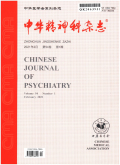认知行为治疗联合氟西汀治疗对自杀未遂青年抑郁症患者脑区比率低频振幅的影响
Altered fractional amplitude of low-frequency fluctuation after cognitive behavioral therapy combined with fluoxetine in young depressed patients with suicide attempts
摘要目的:采用静息态功能磁共振成像(resting-state functional magnetic resonance imaging, rs-fMRI)评估自杀未遂青年抑郁症患者经认知行为治疗(cognitive behavior therapy, CBT)联合氟西汀治疗后脑区比率低频振幅(fractional amplitude of low-frequency fluctuation, fALFF)的变化情况。方法:招募2017年3月至2019年12月来自贵州省第二人民医院的自杀未遂青年抑郁症患者45例,以及与其年龄、性别、受教育程度相匹配的健康志愿者作为对照组。采用随机数字表法将患者分为CBT联合药物治疗组(简称联合组)和单纯抗抑郁药治疗组(简称药物组)。联合组给予8次CBT联合氟西汀抗抑郁治疗;药物组给予单纯氟西汀药物治疗。分别于基线期和治疗后采集rs-fMRI数据,采用HAMD 24、自杀意念量表(Scale for Suicide Ideation, SSI)及其治疗后的减分率(ΔHAMD 24、ΔSSI)评估临床症状和自杀意念程度。采用fALFF分析治疗前后脑功能活动的变化,并对临床心理量表及fALFF值进行相关分析。 结果:基线期联合组fALFF值较对照组显著增高的脑区为左小脑后叶( t=4.312)、右前扣带回( t=4.079)、左顶下小叶/颞上回( t=3.983)、左尾状核( t=4.109)、左额上回/额中回( t=5.191),而左角回( t=-4.607)的fALFF值较对照组显著降低。治疗8周后联合组抑郁症状较药物组显著改善,自杀意念显著降低。治疗8周后联合组fALFF值高于药物组的脑区为右额中回/额下回( t=3.456)、左小脑后叶/小脑前叶( t=5.120);低于药物组的脑区为左额内侧回/膝下前扣带回( t=-4.045; P<0.05,AlphaSim校正)。相关分析示:基线期联合组左额上回fALFF值与HAMD 24分呈负相关( r=-0.600, P=0.002),右前扣带回fALFF值与SSI分呈正相关( r=0.428, P=0.037);治疗8周后,右内侧前额叶fALFF值与SSI减分值(ΔSSI)呈正相关( r=0.518, P=0.010)。 结论:经8周CBT联合药物治疗后,自杀未遂青年抑郁症患者临床疗效显著高于单纯药物治疗,患者脑局部自发活动发生显著改变,尤其以额叶-边缘系统和小脑最为显著,提示CBT联合氟西汀治疗可能对这些脑区的自发性活动产生有效调节并能重塑脑的情感处理过程及认知环路。
更多相关知识
abstractsObjective:This study aimed to evaluate the changes of fractional amplitude of low frequency fluctuation (fALFF) in young depressed patients with suicide attempts after cognitive behavior therapy (CBT) combined with fluoxetine by using the resting-state functional magnetic resonance imaging (rs-fMRI).Method:From March 2017 to December 2019, 45 young depressed patients with suicide attempts were recruited from the Second People′s Hospital of Guizhou Province. The patients were randomly allocated into CBT combined with antidepressant treatment (combination group) and antidepressant treatment alone (antidepressant group). Individuals in combination group were treated with 8-time CBT combined with fluoxetine, patients in antidepressant group were treated with fluoxetine alone. Healthy volunteers matched with the age, gender and education level of the patients were recruited as the control group. The rs-fMRI data were collected before and after the treatment.The clinical symptoms and the suicidal ideation were evaluated by HAMD 24 scale and the Scale for Suicidal Ideation (SSI). The brain function in response to the treatment was analyzed by fALFF, change after the treatment. And the correlation analysis was explored between the brain function and the clinical symptoms. Result:At the baseline, compared with the control group, the fALFF values of combination group were significantly increased in the left posterior lobe ( t=4.312), right anterior cingulate cortex ( t=4.079), left inferior parietal lobe ( t=3.983), left superior temporal cortex ( t=3.983), left caudate nucleus ( t=4.109), left superior frontal cortex ( t=5.191) and left middle frontal cortex ( t=5.191), while significantly decreased in left angular gyrus ( t=-4.607). After 8 weeks of treatment, the depressive symptoms and the suicidal ideation in combination group were significantly improved compared to those in antidepressant group. Compared to antidepressant group, higher fALFF values were found in combination group in right middle frontal cortex ( t=3.456), right inferior frontal cortex ( t=3.456), left posterior cerebellar lobe ( t=5.120), and left anterior cerebellar lobe ( t=5.120); lower values were found in left medial frontal cortex ( t=-4.045), and left anterior cingulate cortex ( t=-4.045; P<0.05, AlphaSim correction). In combination group, the value of fALFF in left superior frontal cortex was negatively correlated with the score of HAMD 24( r=-0.600, P=0.002), and that of right anterior cingulate cortex was positively correlated with SSI score ( r=0.428, P=0.037); after treatment, the value of fALFF in right medial prefrontal lobe was positively correlated with the SSI improvement (ΔSSI) ( r=0.518, P=0.010). Conclusion:After 8 weeks of CBT combined with fluoxetine treatment, depressive symptoms may get more improved with less suicidal ideation than the fluoxetine treatment alone in young depressed patients who have suicide attempts before, and the local spontaneous brain activities change accordingly, especially in the frontal limbic system and cerebellum. It may suggest that CBT combined with fluoxetine may effectively regulate the spontaneous activities of these brain regions and possibly reshape the emotional processing as well as the cognitive circuit which contribute the symptoms improvement.
More相关知识
- 浏览0
- 被引21
- 下载0


相似文献
- 中文期刊
- 外文期刊
- 学位论文
- 会议论文



 换一批
换一批 换一批
换一批



